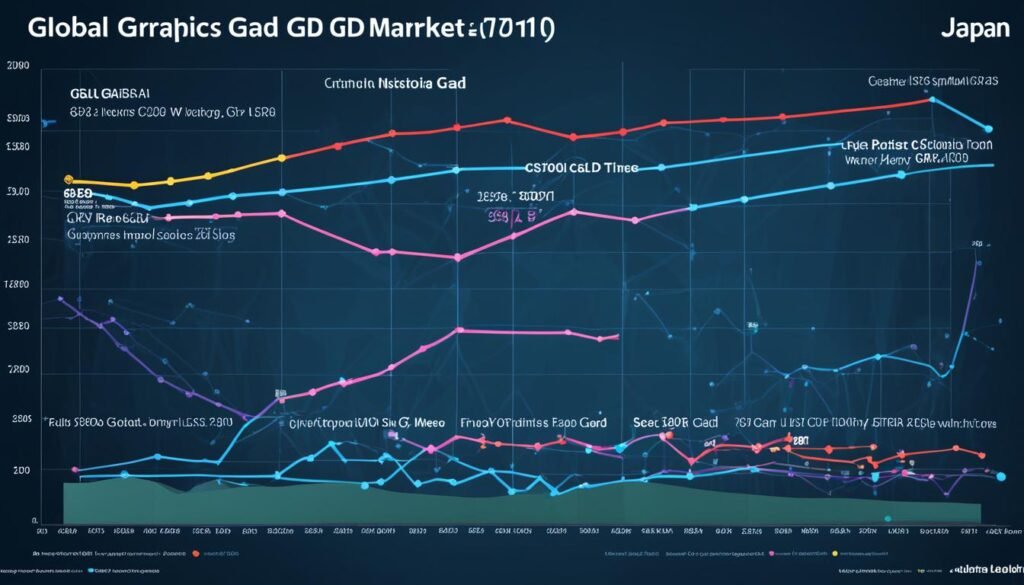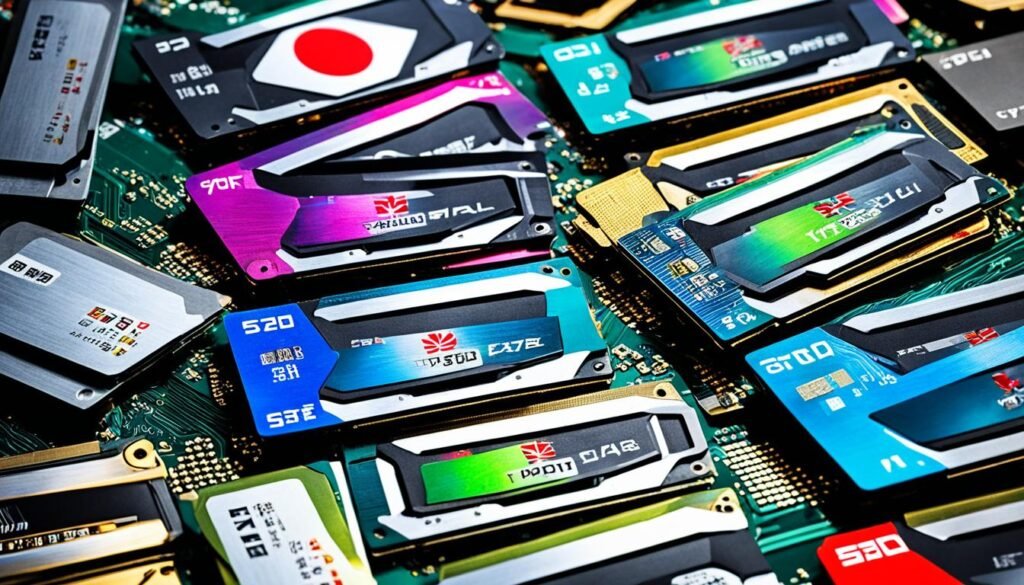Tech enthusiasts and gamers are always searching for the best deals. But, is it cheaper to buy graphics cards in Japan? Compared to the U.S. and Canada, prices in Japan can be higher, around 1.5 times more. This makes people wonder if it’s a smart buy and if the new models are really worth the money. Despite higher prices, often 2 to 3 times the original cost, the situation changes due to supply and demand issues12. On the other hand, second-hand graphics cards in Japan can be 20-30% less expensive than new ones. This offers a cheaper option for those looking to save3.
Key Takeaways
- Graphics card prices in Japan can be significantly higher than in the U.S. and Canada.
- Japan’s second-hand market for GPUs provides more affordable options.
- Promotions and seasonal sales can lower prices in physical stores.
- Major sales events like Black Friday may lead to price drops in Japan.
- Current market trends indicate varied pricing based on supply and demand.
Introduction to Graphics Card Pricing
Graphics card prices in Japan change for many reasons. Brand strength, tech specs, and market trends play big roles. Nvidia and AMD are leading names, setting prices around the world4. They have different models that perform in various ways, setting the scene for pricing. For example, the AMD Radeon RX 7900 GRE starts at $549 globally. It’s a tough rival for Nvidia’s RTX 4070 and RTX 4070 Super in games and making images5. The GeForce RTX 4070 Super uses 220W and is liked for its good balance of performance and special effects5.
In Japan, what people want greatly affects graphics card prices. Cards like the Nvidia RTX 4080 Super are popular for their top-notch 4K gaming without being too pricey compared to the RTX 40805. Plus, cards with new tech like ray tracing and smart resolution are becoming more popular4.
The shortage of semiconductor chips worldwide makes it hard to get these cards6. The market is expected to grow a lot, hinting at future price changes and availability6. As the competition heats up, both old and new companies will play a part in setting prices in places like Japan.
| Graphics Card Model | Starting Price | Key Features |
|---|---|---|
| AMD Radeon RX 7900 GRE | $549 | Strong gaming performance, rasterization |
| Nvidia GeForce RTX 4070 Super | Approx. $600 | 220W power draw, 12GB GDDR6X memory, strong ray tracing |
| Nvidia RTX 4080 Super | Approx. $1,199 | Outstanding 4K performance |
| AMD Radeon RX 7800 XT | $399 | Ideal for 1440p gaming |
| Nvidia RTX 4060 | Under $300 | Top option for 1080p gaming with DLSS 3 |
| Intel Arc A770 | Approx. $329 | Great price-performance ratio |
Understanding the Global Graphics Card Market
In recent years, the global graphics card market has seen a lot of changes. These changes come from how much supply and demand there is. Because the market is all connected, a shortage in one area can affect prices everywhere.
The impact of supply and demand on pricing
Nowadays, more people want high-performance graphics cards for gaming and making content. This has made prices go up because there aren’t enough cards for everyone. The value of the graphics card market in Japan was a lot in 2023. It’s expected to grow even more by 2031. This growth is mostly because esports are getting more popular, and gamers need good GPUs.
Companies like NVIDIA and AMD are at the forefront, constantly bringing new and better products to the market7.
How global shortages affect local markets
These worldwide shortages are making prices rise and forcing local markets to adapt. For example, in the entertainment industry, there’s a big need for fast rendering and powerful GPUs. This has made things even more challenging. In places like Japan, more people moving to cities and having more money to spend is good for the market, but it also makes prices go up7.

Data science and AI also need these high-powered graphics cards, showing they have many uses8. So, the rising demand and limited supply make the graphics card market a tricky one to navigate. Both buyers and businesses must watch the market closely and plan carefully.
Graphics Cards Pricing in Japan
Knowing how graphics card prices work in Japan helps buyers make smart choices. The current market trends show big price differences. These are due to global markets and how people in Japan buy. When we look into it, we see some interesting facts about prices there.
Current market trends and statistics
In Japan, graphics cards tend to be more expensive than in other countries. For example, the Nvidia RTX 4090 costs about $2,500 in Japan, which is much higher than its $1,599 price in the USA3. On the other hand, the AMD Radeon RX 6600 is around $160. This shows it competes well in the global market3.
Used graphics cards are usually 20-30% cheaper than new ones. This is good for those watching their budget3. Online shops often have better deals on graphics cards in Japan. This helps bring down prices3. With big sales events coming, like Black Friday and New Year’s, prices tend to drop. This gives smart buyers a chance to save money3.
Comparison of prices with major brands
The graphics card market shows big price differences between major brands. The market for compact graphics cards is expected to grow a lot. It might reach USD xx.x billion by 2031, growing steadily from 2024 to 20319. This boom is due to more demand for small, powerful cards, especially in Asia-Pacific. This demand impacts local prices9.
| Brand | Japan Price (USD) | USA Price (USD) |
|---|---|---|
| Nvidia RTX 4090 | $2,500 | $1,599 |
| AMD Radeon RX 6600 | $160 | N/A |
Big names like AMD, NVIDIA, and ASUS lead this market. They adjust their prices based on what locals need9. With changes in lifestyle and tech, there’s more need for smaller, yet strong, graphics cards. Knowing about graphics cards pricing in Japan is key to buying wisely.
Are Graphics Cards Cheaper in Japan?
Many tech enthusiasts wonder if it’s cheaper to buy graphics cards in Japan. But the truth may surprise you. In Japan, graphics card prices can be way higher than in the USA. Sometimes, they can cost between 1.5 to 3 times more than the suggested price10.
Take the GeForce RTX 3090 Ti and RTX 3080 Ti, for example. These cards have lots of CUDA Cores and high Boost Clock speeds. But they’re sold at steep prices in Japan11.
Even during big sales like Prime Day and Black Friday, GPU prices don’t drop much10. These graphics cards come with a ton of memory, using the latest GDDR6X technology11. Sadly, many buyers find out the hard way that deals in Japan are not as good as they hoped.
So, if you’re thinking about getting a graphics card in Japan, think again. It’s vital to stay updated on price trends. Remember, new GPU models like the RTX 5080 are on the way, which could shake up prices even more10.

Reasons Behind High Graphics Card Prices in Japan
Graphics card prices in Japan are high due to many reasons. Import tariffs and market dynamics play a big role. These factors shed light on why prices are up and the buying situation. The country’s strict import tariffs and taxes on electronics can raise costs. So, that makes graphics cards more expensive at stores. This creates a heavy cost for buyers.
Import tariffs and taxes
Import tariffs are key in setting graphics card prices. Japan’s government puts duties on imported electronics, affecting what you pay at the end. For instance, the Nvidia RTX 4090 costs about $2,500 in Japan, way more than its $1,599 MSRP in the USA3. This shows how tariffs can cause big price differences. Thus, Japanese consumers often have to deal with these higher prices.
Market demand and local purchasing power
In Japan, demand for graphics cards also drives up prices. A big number of tech fans and gamers want the latest models. Sometimes, prices for certain graphics cards rise by 60% due to shortages12. How much people can spend affects prices too. Retailers set prices based on what they think people will pay. Changes in the yen’s value against the dollar also play a part.
Retailers like Bic Camera and Yodobashi Camera try to offer good deals. Yet, the overall demand in Japan means prices are still high3.
Buying Graphics Cards in Japan: What to Know
When you think about buying graphics cards in Japan, keep some key points in mind. Compatibility with global standards is usually there. Yet, there are some differences that might impact your use.
Compatibility issues to consider
Always check if the graphics card fits your system before buying. Brands like Nvidia and AMD usually work well. But, you might face compatibility issues with certain hardware or unique Japanese models. These special models might work better in Japan but are harder to find abroad.
Warranty considerations for international purchases
Warranty terms can vary by brand and where you buy. Some companies, like EVGA, offer worldwide warranties. This is a benefit for buying graphics cards in Japan. Make sure you understand the warranty for your card. Knowing this can help if you run into problems later. For more details, check out this link: graphics card pricing trends in Japan3.
| Graphics Card Model | Price in Japan | Price in the USA | Price Comparison |
|---|---|---|---|
| Nvidia RTX 4090 | $2,500 | $1,599 | Higher in Japan |
| AMD Radeon RX 6600 | $160 | $X (varies) | Competitive globally |
| Second-hand Cards | 20-30% lower than new | N/A | Budget-friendly options |
Knowing these key points can make your buying graphics cards in Japan a smooth experience. It helps to pick the right product for your needs1.
Best Deals on Graphics Cards in Japan
Searching for top graphics card deals in Japan is exciting for tech fans. You can choose from many places, like web stores or local shops. It’s all about finding the best sales to fit your budget.
Where to look for discounts and sales
Web platforms usually have the top graphics card deals. For example, Amazon Japan often has good prices. The XFX Speedster MERC310 AMD Radeon RX 7900 XTX Black GPU costs $869.99. Meanwhile, the Sapphire PULSE AMD Radeon RX 7900 XT GPU is $679.99. This makes them great for those watching their spending13. Also, the NVIDIA GeForce RTX 4060 is just $299.99 on Newegg14. Look out for big sales throughout the year for extra savings.
Online vs. physical store experiences
Shopping online is handy, but local stores have their perks too. Big electronics stores let you see items up close and ask questions. Brands like MSI, NVIDIA, and AMD often have special sections in these shops. This way, you can check out the graphics cards yourself. Plus, shopping in person means you can take your item home right away. For example, the ASUS ROG XG External GeForce RTX 4090 Graphics Card sells for $1,499.9913. It’s a good idea to compare online and in-store deals to find the best buy.
| Graphics Card Model | Price (USD) | Discount |
|---|---|---|
| XFX Speedster MERC310 AMD Radeon RX 7900 XTX | $869.99 | 13% off |
| Sapphire PULSE AMD Radeon RX 7900 XT | $659.99 | 18% off |
| NVIDIA GeForce RTX 4060 | $299.99 | None |
| Gigabyte GeForce RTX 4070 AERO OC V2 | $509.99 | 15% off |
| MSI GeForce RTX 4070 Ti Super OC | $789.99 | None |
Comparison: Graphics Card Prices in Japan vs. the U.S.
The ongoing comparison of graphics card prices between Japan and the U.S. shows big differences. For example, Nvidia’s top RTX 4090 costs over $1,500 in the U.S. In Japan, its price is the same or even higher because of import taxes and changing demand15. On the other hand, AMD’s Radeon RX 7900 XTX is about $999.99 in the U.S. This makes it a better deal for those saving money, unlike its Nvidia rival15.
Buyers in Japan and the U.S. face different challenges when buying graphics cards. In Japan, gamers often struggle to find cards due to low stock and high prices caused by import fees. Getting models like the RTX 4070 and RX 7800 XT is tough15. But in the U.S., there’s more stock. Customers also find deals that make buying cards cheaper, especially during sales16.
Customer feedback reveals a strong preference for shopping in the U.S. because of better prices and active online shops. While shops in Japan are convenient, the U.S. has the upper hand in costs. U.S. stores keep their stock fresh and give big discounts on popular models like Intel Arc A770 and Nvidia’s mid-range cards5. So, knowing these differences helps buyers make smarter choices in a changing market.










